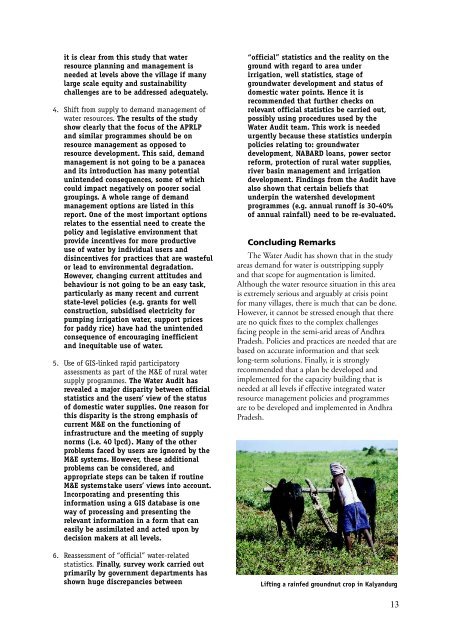Download full report in pdf format - Natural Resources Institute
Download full report in pdf format - Natural Resources Institute
Download full report in pdf format - Natural Resources Institute
You also want an ePaper? Increase the reach of your titles
YUMPU automatically turns print PDFs into web optimized ePapers that Google loves.
it is clear from this study that water<br />
resource plann<strong>in</strong>g and management is<br />
needed at levels above the village if many<br />
large scale equity and susta<strong>in</strong>ability<br />
challenges are to be addressed adequately.<br />
4. Shift from supply to demand management of<br />
water resources. The results of the study<br />
show clearly that the focus of the APRLP<br />
and similar programmes should be on<br />
resource management as opposed to<br />
resource development. This said, demand<br />
management is not go<strong>in</strong>g to be a panacea<br />
and its <strong>in</strong>troduction has many potential<br />
un<strong>in</strong>tended consequences, some of which<br />
could impact negatively on poorer social<br />
group<strong>in</strong>gs. A whole range of demand<br />
management options are listed <strong>in</strong> this<br />
<strong>report</strong>. One of the most important options<br />
relates to the essential need to create the<br />
policy and legislative environment that<br />
provide <strong>in</strong>centives for more productive<br />
use of water by <strong>in</strong>dividual users and<br />
dis<strong>in</strong>centives for practices that are wasteful<br />
or lead to environmental degradation.<br />
However, chang<strong>in</strong>g current attitudes and<br />
behaviour is not go<strong>in</strong>g to be an easy task,<br />
particularly as many recent and current<br />
state-level policies (e.g. grants for well<br />
construction, subsidised electricity for<br />
pump<strong>in</strong>g irrigation water, support prices<br />
for paddy rice) have had the un<strong>in</strong>tended<br />
consequence of encourag<strong>in</strong>g <strong>in</strong>efficient<br />
and <strong>in</strong>equitable use of water.<br />
5. Use of GIS-l<strong>in</strong>ked rapid participatory<br />
assessments as part of the M&E of rural water<br />
supply programmes. The Water Audit has<br />
revealed a major disparity between official<br />
statistics and the users’ view of the status<br />
of domestic water supplies. One reason for<br />
this disparity is the strong emphasis of<br />
current M&E on the function<strong>in</strong>g of<br />
<strong>in</strong>frastructure and the meet<strong>in</strong>g of supply<br />
norms (i.e. 40 lpcd). Many of the other<br />
problems faced by users are ignored by the<br />
M&E systems. However, these additional<br />
problems can be considered, and<br />
appropriate steps can be taken if rout<strong>in</strong>e<br />
M&E systemstake users’ views <strong>in</strong>to account.<br />
Incorporat<strong>in</strong>g and present<strong>in</strong>g this<br />
<strong>in</strong><strong>format</strong>ion us<strong>in</strong>g a GIS database is one<br />
way of process<strong>in</strong>g and present<strong>in</strong>g the<br />
relevant <strong>in</strong><strong>format</strong>ion <strong>in</strong> a form that can<br />
easily be assimilated and acted upon by<br />
decision makers at all levels.<br />
6. Reassessment of “official” water-related<br />
statistics. F<strong>in</strong>ally, survey work carried out<br />
primarily by government departments has<br />
shown huge discrepancies between<br />
“official” statistics and the reality on the<br />
ground with regard to area under<br />
irrigation, well statistics, stage of<br />
groundwater development and status of<br />
domestic water po<strong>in</strong>ts. Hence it is<br />
recommended that further checks on<br />
relevant official statistics be carried out,<br />
possibly us<strong>in</strong>g procedures used by the<br />
Water Audit team. This work is needed<br />
urgently because these statistics underp<strong>in</strong><br />
policies relat<strong>in</strong>g to: groundwater<br />
development, NABARD loans, power sector<br />
reform, protection of rural water supplies,<br />
river bas<strong>in</strong> management and irrigation<br />
development. F<strong>in</strong>d<strong>in</strong>gs from the Audit have<br />
also shown that certa<strong>in</strong> beliefs that<br />
underp<strong>in</strong> the watershed development<br />
programmes (e.g. annual runoff is 30-40%<br />
of annual ra<strong>in</strong>fall) need to be re-evaluated.<br />
Conclud<strong>in</strong>g Remarks<br />
The Water Audit has shown that <strong>in</strong> the study<br />
areas demand for water is outstripp<strong>in</strong>g supply<br />
and that scope for augmentation is limited.<br />
Although the water resource situation <strong>in</strong> this area<br />
is extremely serious and arguably at crisis po<strong>in</strong>t<br />
for many villages, there is much that can be done.<br />
However, it cannot be stressed enough that there<br />
are no quick fixes to the complex challenges<br />
fac<strong>in</strong>g people <strong>in</strong> the semi-arid areas of Andhra<br />
Pradesh. Policies and practices are needed that are<br />
based on accurate <strong>in</strong><strong>format</strong>ion and that seek<br />
long-term solutions. F<strong>in</strong>ally, it is strongly<br />
recommended that a plan be developed and<br />
implemented for the capacity build<strong>in</strong>g that is<br />
needed at all levels if effective <strong>in</strong>tegrated water<br />
resource management policies and programmes<br />
are to be developed and implemented <strong>in</strong> Andhra<br />
Pradesh.<br />
Lift<strong>in</strong>g a ra<strong>in</strong>fed groundnut crop <strong>in</strong> Kalyandurg<br />
13

















